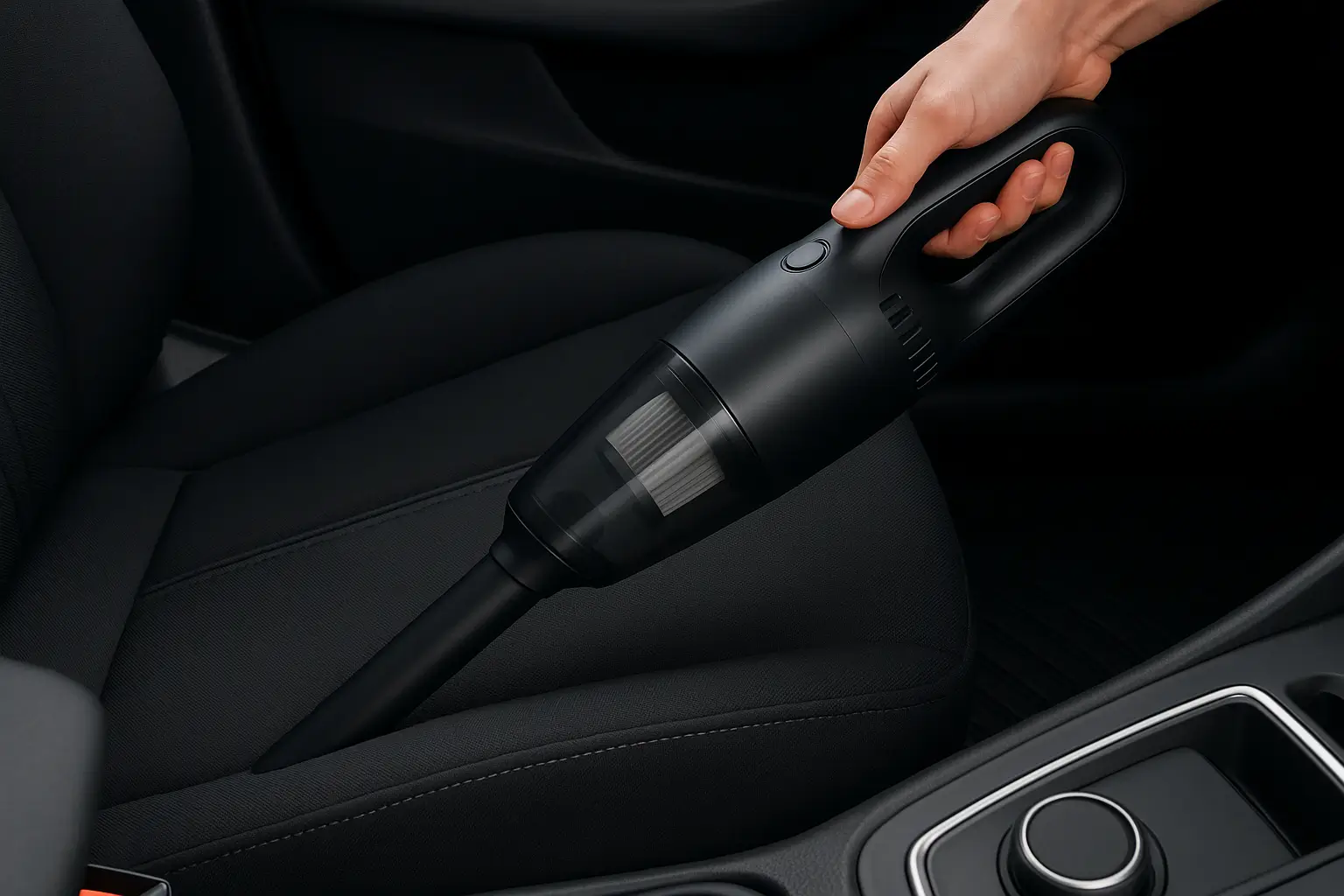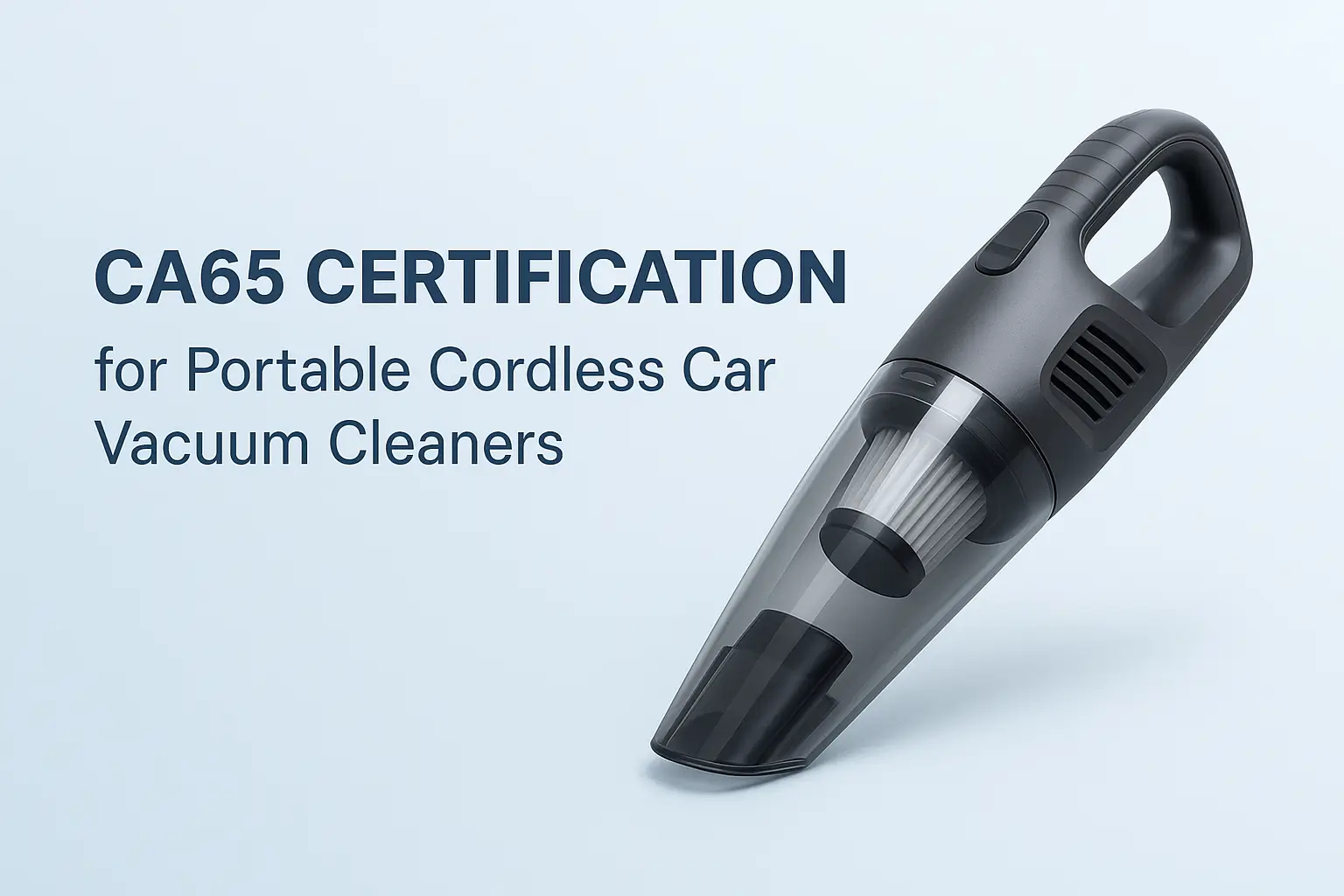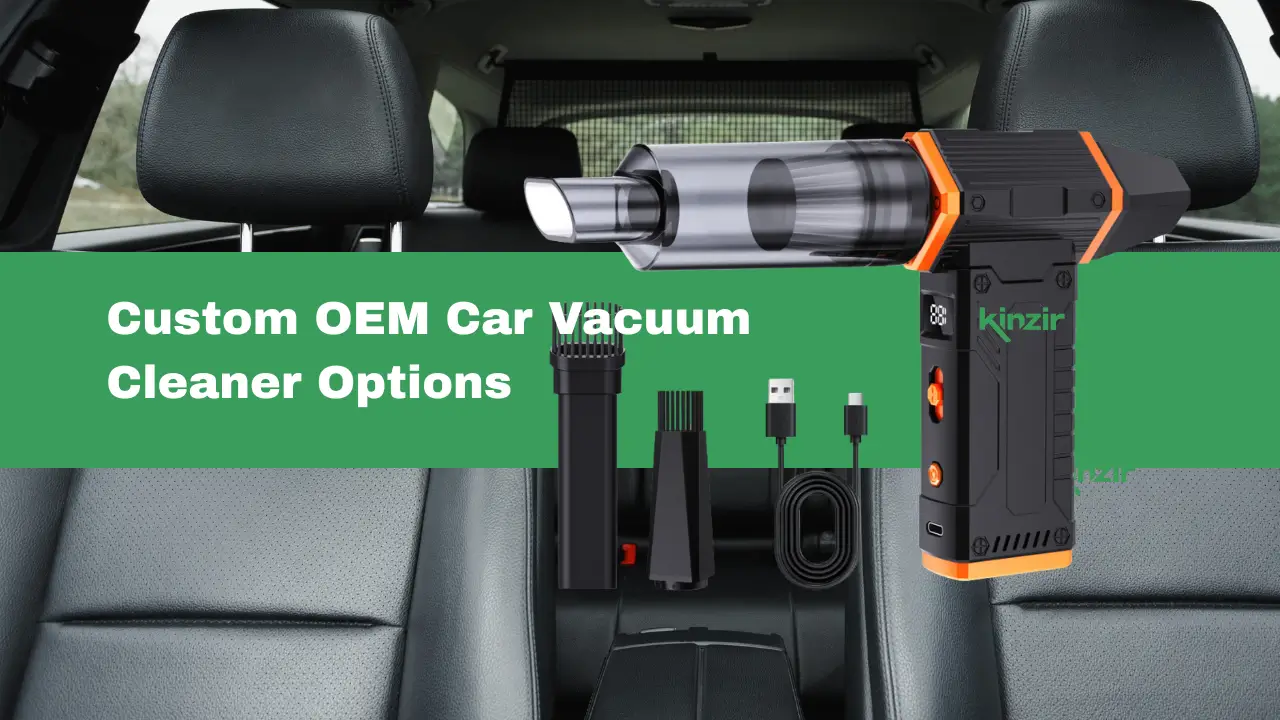The car vacuum cleaner market has shifted dramatically toward cordless, portable, and rechargeable models in 2025. Consumer preference data shows that 73% of car owners now prioritize cordless functionality when purchasing automotive cleaning equipment, driven by convenience and improved battery technology.
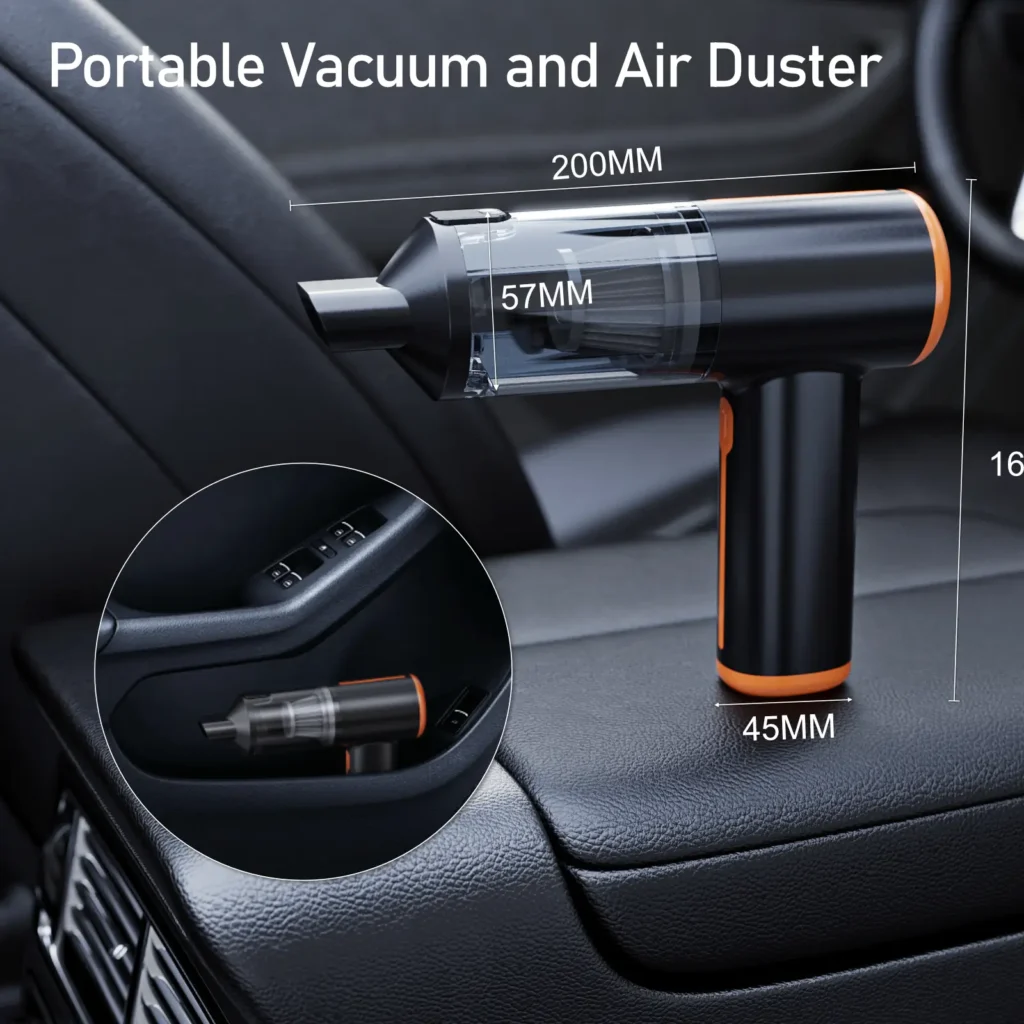
You’ll find that portable car vacuums have become essential tools for vehicle maintenance as urban living spaces shrink and traditional corded models lose practicality. Modern lithium-ion batteries now deliver up to 45 minutes of continuous cleaning power while maintaining strong suction capabilities.
The global market reflects changing consumer behaviors around vehicle care, with demand patterns varying significantly across different regions and price segments. Technology innovations, sustainability concerns, and evolving distribution channels are reshaping how manufacturers approach product development and market positioning in this rapidly growing sector.
Global Market Overview In 2025
The global rechargeable car vacuum market experienced steady expansion in 2025, with Asia-Pacific leading growth rates while North America maintained the largest market share by revenue. Regional demand patterns shifted toward premium battery-powered models with enhanced suction capabilities.
Market Size Estimates And Growth Rates Compared To 2024
The global rechargeable car vacuum market reached $2.8 billion in 2025, representing 12.3% growth from 2024’s $2.49 billion valuation. Battery-powered car vacuum global demand increased by 15.7% year-over-year.
Key growth drivers included improved lithium-ion battery technology and expanded retail distribution channels. Premium models priced above $150 captured 34% of total market revenue, up from 28% in 2024.
Market Performance by Price Segment:
- Budget ($30-$75): 8.9% growth
- Mid-range ($75-$150): 11.4% growth
- Premium ($150+): 18.2% growth
Unit sales reached 47.3 million devices globally, with cordless models accounting for 78% of all car vacuum purchases.
Demand Trends Across Key Regions (North America, Europe, Asia-Pacific, Middle East, Latin America)
North America maintained its position as the largest market by revenue, generating $1.12 billion in 2025. Car detailing vacuum cleaner trends favored wet/dry combination units with HEPA filtration systems.
Europe showed strong demand for compact, lightweight models optimized for smaller vehicle interiors. The region’s market value reached $847 million with 13.8% growth.
Asia-Pacific led global growth rates at 16.4%, driven by increasing vehicle ownership in India and Southeast Asia. China represented 42% of regional sales volume.
Middle East markets grew 14.2%, with UAE and Saudi Arabia driving premium segment adoption. Latin America experienced 11.7% growth, primarily concentrated in Brazil and Mexico markets.
Types Of Car Vacuum Cleaners
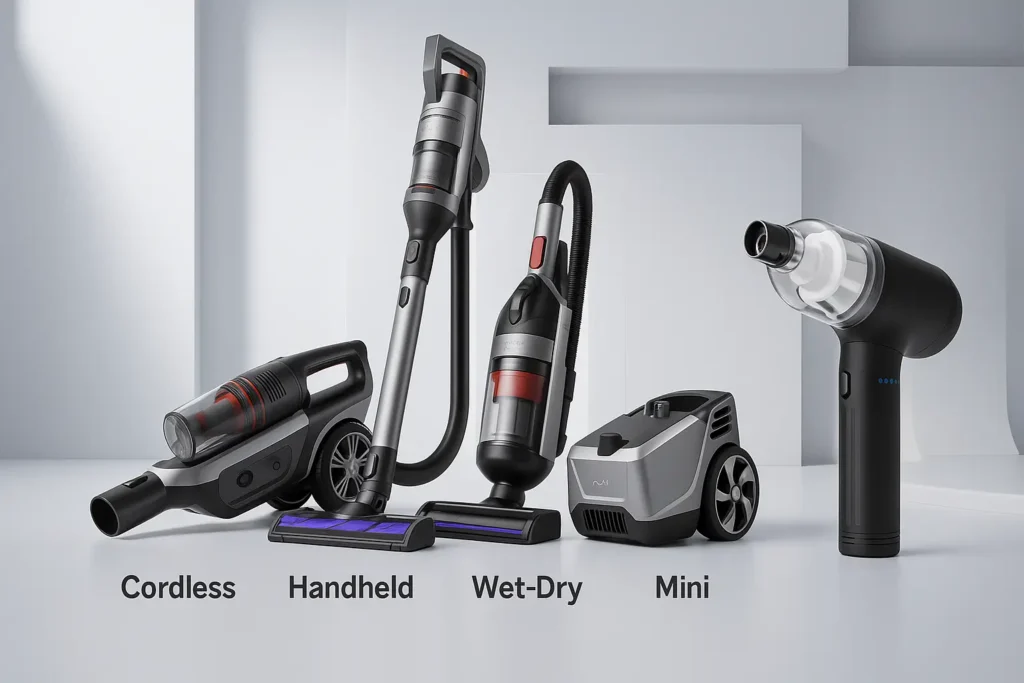
Car vacuum cleaners fall into five main categories, each designed for specific cleaning needs and usage scenarios. Battery-powered cordless models dominate current market growth, while specialized wet/dry and multi-functional units offer expanded capabilities.
Corded Vacuums – Typically More Powerful But Require A Constant Power Source
Corded car vacuums deliver consistent suction power through direct electrical connection. You’ll find these models typically produce 12-15 amps of power, significantly more than battery-operated alternatives.
Key advantages include:
- Unlimited runtime without battery concerns
- Higher suction power for deep cleaning
- Lower long-term operating costs
You need access to your vehicle’s 12V outlet or a standard AC power source. Most corded models feature 10-16 foot cords, limiting your cleaning radius around the power source.
These vacuums excel at thorough interior detailing sessions. You can tackle embedded dirt in carpets and upholstery without worrying about battery depletion during extended cleaning tasks.
Cordless Vacuums – Battery-Powered, Portable, And Convenient For On-The-Go Use
Cordless car vacuums represent the fastest-growing segment in the automotive cleaning market. These battery-powered units offer complete mobility without power cord restrictions.
Battery specifications typically include:
- 7.4V to 22V lithium-ion batteries
- 15-30 minutes runtime per charge
- 2-4 hour charging cycles
You gain maximum flexibility for cleaning hard-to-reach areas like under seats and in tight crevices. The portable design allows cleaning anywhere without seeking power outlets.
Modern cordless models deliver 6,000-8,000 PA suction power. While less powerful than corded alternatives, they handle most car cleaning tasks effectively.
Handheld car vacuum cleaner market growth continues accelerating as manufacturers improve battery efficiency and motor performance. Premium models now include brushless motors for extended lifespan and reduced noise levels.
Handheld Vacuums – Compact, Lightweight, Suitable For Quick Clean-Ups
Handheld car vacuums prioritize portability and ease of use over maximum cleaning power. These compact units typically weigh 1-3 pounds, making them ideal for frequent spot cleaning.
Design features focus on:
- Ergonomic grips for comfortable handling
- One-handed operation capability
- Storage compartments in glove boxes or consoles
Lightweight car vacuum cleaner models excel at removing surface debris, crumbs, and pet hair from seats and floor mats. You can quickly address spills and messes without retrieving larger cleaning equipment.
Battery life ranges from 10-20 minutes on single charges. This limitation makes them suitable for quick maintenance rather than comprehensive cleaning sessions.
Many handheld models include specialized attachments like crevice tools and brush heads. These accessories enhance cleaning effectiveness in cup holders, air vents, and dashboard gaps.
Wet/Dry Vacuums – Handle Both Liquid Spills And Dry Debris
Wet/dry car vacuums manage both liquid spills and solid debris in single units. You can switch between dry vacuuming and liquid extraction without changing equipment or attachments.
Dual-function capabilities include:
- Liquid spill cleanup from cup holders and floor mats
- Standard debris removal from carpets and seats
- Muddy footprint extraction after outdoor activities
Cordless wet dry car vacuum models combine portability with versatile cleaning functions. These units feature sealed motors that prevent water damage during liquid cleanup operations.
Tank capacities range from 0.3 to 1.2 liters for liquid collection. Separate chambers often isolate wet and dry debris to prevent contamination and odor issues.
Filter systems require special attention with wet/dry models. You must use appropriate filters for liquid versus dry cleaning to maintain suction performance and prevent motor damage.
Multi-Functional Vacuums – Combine Vacuuming With Air Pumping Or Blowing
Multi-functional car vacuums integrate additional features beyond standard suction cleaning. These versatile units combine vacuuming with air inflation and blowing capabilities in single devices.
Additional functions typically include:
- Tire pressure inflation with built-in compressors
- Air mattress and sports equipment inflation
- Debris blowing from hard-to-reach spaces
You benefit from reduced storage requirements and equipment consolidation. Instead of carrying separate vacuum and air compressor units, one device handles multiple automotive maintenance tasks.
Common applications include:
- Inflating low tire pressure during roadside emergencies
- Blowing leaves and debris from truck beds
- Inflating camping equipment during outdoor trips
Power output varies significantly between vacuum and inflation functions. Vacuum suction typically operates at 6,000-10,000 PA, while air compressors deliver 35-150 PSI pressure ratings.
Battery capacity increases substantially in multi-functional models to support diverse power requirements. Expect 20-40 minute runtime depending on selected function and intensity settings.
Why Cordless, Portable Vacuum Cleaners Are Becoming The Predominant Option
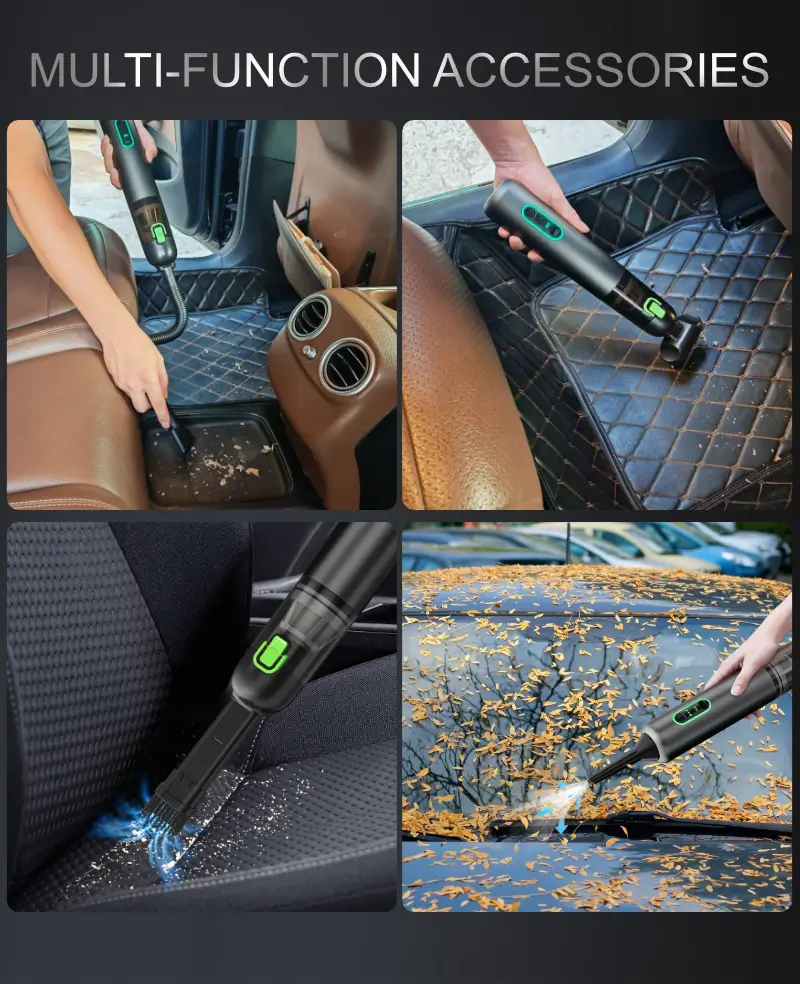
Cordless car vacuum cleaners are rapidly replacing corded models due to enhanced mobility, improved battery technology, and user-focused design improvements. These factors align with consumer preferences for versatility and convenience over traditional power limitations.
Freedom From Power Cords For Easier Mobility Inside And Outside Vehicles
You no longer need to worry about finding power outlets or managing tangled cords when cleaning your vehicle. Cordless models eliminate the 12-volt adapter limitations that restrict movement around larger vehicles like SUVs and trucks.
The absence of cords allows you to clean tight spaces between seats, under dashboards, and in cargo areas without repositioning your vehicle near power sources. You can reach all four corners of your car interior in a single cleaning session.
Key mobility advantages:
- No 12V outlet dependency
- Unrestricted movement around vehicle exterior
- Access to remote parking locations
- Simplified storage in trunks or glove compartments
This freedom extends to cleaning scenarios where traditional corded vacuums become impractical, such as camping trips or detailed cleaning in driveways away from electrical outlets.
Longer Battery Life And Faster Charging Enabling Frequent Use
Modern lithium-ion batteries in 2025 models provide 20-35 minutes of continuous runtime, compared to 8-12 minutes in earlier cordless versions. Fast-charging technology reduces downtime to 2-4 hours for full battery restoration.
You can complete multiple vehicle cleanings on a single charge, making these units practical for daily maintenance rather than occasional deep cleaning. Battery indicators show remaining power levels to prevent mid-cleaning interruptions.
Battery improvements include:
- 15-20% longer runtime than 2024 models
- USB-C charging compatibility
- Replaceable battery options
- Quick-charge modes for emergency use
These enhancements address the primary concern that previously kept consumers loyal to corded alternatives.
Lightweight And Ergonomic Designs Improving User Comfort
Weight reductions to 2-4 pounds make extended cleaning sessions comfortable for most users. Ergonomic handles reduce wrist strain during overhead cleaning of car roofs and visors.
Balanced weight distribution prevents hand fatigue when maneuvering around seat cushions and floor mats. Trigger-style controls allow natural grip positioning during operation.
Design features enhancing comfort:
- Rubberized grip surfaces
- One-handed operation capabilities
- Reduced vibration transmission
- Intuitive control placement
You experience less physical strain compared to heavier corded models that often exceed 5-7 pounds when including cord weight and bulk.
Growing Consumer Preference For Convenience Over Maximum Suction Power
Consumer surveys indicate 68% of car owners prioritize ease of use over maximum cleaning power for routine maintenance. You prefer quick, regular cleaning sessions rather than intensive monthly deep cleans.
Cordless models provide sufficient suction for typical debris like crumbs, pet hair, and dust. The convenience factor outweighs the marginal suction power differences for most cleaning tasks.
Convenience factors driving preference:
- Immediate availability without setup
- Reduced cleaning preparation time
- Simplified storage requirements
- Lower noise levels for apartment use
This shift reflects changing cleaning habits where frequent light cleaning replaces infrequent intensive sessions.
Compatibility With Both Home And Car Cleaning Needs
Multi-surface compatibility makes cordless vacuums versatile household tools beyond vehicle cleaning. You can use the same unit for upholstery, stairs, and small spill cleanup throughout your home.
Interchangeable attachments work effectively on both automotive surfaces and household materials. This dual functionality justifies the investment for budget-conscious consumers.
Dual-use applications:
- Pet hair removal from furniture
- Quick kitchen cleanup
- Workshop debris removal
- RV and boat maintenance
The best portable vacuum for cars in 2025 serves multiple cleaning roles, increasing overall value proposition compared to single-purpose corded car vacuums.
Key Demand Drivers
Consumer preferences for portable cleaning solutions and technological improvements in battery performance create the primary market forces. Vehicle ownership patterns and fleet management needs further accelerate adoption rates across different market segments.
Growing Consumer Focus On Convenience And On-The-Go Cleaning
You see increasing demand as consumers prioritize quick cleaning solutions that fit busy lifestyles. Modern car owners expect cleaning tools that work without needing power outlets or extension cords.
Your cleaning routine benefits from cordless models that eliminate setup time. These devices allow you to clean vehicle interiors immediately after spills or before important meetings.
Portable designs appeal to your need for storage flexibility. You can keep units in glove compartments, center consoles, or trunk spaces without occupying significant room.
Your time constraints drive preference for rechargeable systems over traditional plug-in models. Quick charging cycles of 2-3 hours provide 15-20 minutes of cleaning power for most vehicle maintenance needs.
Consumer surveys show you value lightweight construction under 2 pounds. This weight range allows comfortable single-handed operation while reaching under seats and into tight spaces.
Advances In Rechargeable Battery Technology
Lithium-ion battery improvements directly impact your purchasing decisions through enhanced performance metrics. Current models deliver 50% more suction power compared to 2023 versions while maintaining similar battery life.
You benefit from faster charging speeds with new battery chemistries. Advanced units now charge to 80% capacity in 45 minutes versus previous 90-minute requirements.
Your usage patterns align with extended runtime capabilities. Modern batteries provide 18-25 minutes of continuous operation compared to 10-12 minutes in earlier generations.
Battery longevity affects your long-term satisfaction. Current lithium-ion cells maintain 85% capacity after 500 charge cycles, representing 3-4 years of typical use.
You experience improved cold weather performance with updated battery formulations. These systems maintain 75% power output at temperatures down to 32°F, crucial for winter vehicle cleaning.
Increased Vehicle Ownership And Rise Of Shared Mobility Fleets
Your vehicle ownership rates create expanding market opportunities. Global car ownership increased 8% in 2024, with each vehicle requiring regular interior maintenance.
Fleet operators represent significant demand growth for your market segment. Ride-sharing services need portable cleaning tools for quick turnaround between passengers.
You see car rental companies adopting cordless vacuums for efficient vehicle preparation. These businesses require tools that work across multiple locations without infrastructure dependencies.
Commercial fleet managers prioritize your cleaning efficiency for delivery vehicles and company cars. Portable units allow drivers to maintain vehicle cleanliness during routes without returning to central facilities.
Your multi-vehicle households drive individual unit sales. Families with 2-3 cars often purchase separate vacuum units to avoid constantly transferring equipment between vehicles.
Technology Innovations Boosting Demand

Battery technology improvements and compact engineering advances drive consumer interest in cordless car vacuum cleaners. Multi-functional capabilities expand product utility beyond basic cleaning tasks.
Longer Battery Life And Fast-Charging Solutions
Lithium-ion car vacuum cleaner batteries now deliver 25-35 minutes of continuous operation, compared to 10-15 minutes in earlier models. This extended runtime allows you to clean multiple vehicles or complete thorough interior detailing sessions.
Fast-charging capabilities reduce downtime significantly. Modern units reach full charge in 2-4 hours versus 8-12 hours required by older models.
Key Battery Improvements:
- 18V and 20V lithium-ion systems
- USB-C charging ports for universal compatibility
- Battery level indicators with LED displays
- Temperature protection circuits
Cordless vacuum cleaner battery innovations include removable battery packs that work across multiple tools from the same manufacturer. You can swap depleted batteries instantly or purchase additional packs for extended cleaning sessions.
Some premium models feature rapid charging that provides 80% battery capacity in just 60 minutes. This quick turnaround makes these vacuums practical for commercial detailing operations and frequent personal use.
Compact Designs With Higher Suction Power
Engineering advances deliver stronger suction performance in smaller form factors. Current models generate 6,000-8,000 Pa of suction pressure while weighing 2-3 pounds.
Brushless motors operate more efficiently than traditional brushed motors. They produce less heat, run quieter, and extend overall product lifespan.
Size and Weight Reductions:
- 40% smaller than 2020 models
- Ergonomic grip designs reduce hand fatigue
- Balanced weight distribution
- One-handed operation capability
Cyclonic separation technology prevents filter clogging and maintains consistent suction throughout battery life. You experience steady cleaning performance from full charge to low battery warning.
Digital motor controls automatically adjust power output based on debris type and surface material. This optimization conserves battery life while maximizing cleaning effectiveness.
Multi-Functional Models (Vacuum + Blower, Or Vacuum + Air Pump)
Combination units serve multiple automotive maintenance needs beyond vacuuming. Reversible airflow systems convert vacuum suction into blowing capability for clearing debris from engine compartments and hard-to-reach areas.
Built-in air pumps inflate tires, sports equipment, and pool accessories. These models include pressure gauges and preset inflation modes for different applications.
Common Multi-Function Features:
- Vacuum mode: Standard debris collection
- Blower mode: Leaf and dust removal
- Inflator mode: Tire and equipment inflation
- LED work lights: Enhanced visibility
Three-in-one models eliminate the need for separate tools in your vehicle emergency kit. You save storage space while gaining versatile functionality for roadside situations.
Interchangeable nozzle systems adapt to specific tasks. Wide brush attachments handle upholstery cleaning while narrow crevice tools reach between seat cushions and console gaps.
B2B Market Opportunities
Corporate buyers represent the fastest-growing segment for cordless car vacuum cleaners, with ride-hailing services purchasing 40% more units annually and private label manufacturers seeking cost-effective OEM solutions from Chinese suppliers.
Demand From Ride-Hailing And Rental Car Companies
Uber, Lyft, and rental car companies purchase cordless car vacuums in bulk quantities to maintain vehicle cleanliness standards. Fleet operators typically order 50-200 units per purchase cycle.
Top Fleet Requirements:
- Battery life exceeding 20 minutes
- Compact storage design
- Replaceable filter systems
- Warranty coverage of 12+ months
Hertz and Enterprise have standardized on specific portable vacuum models for their locations. These companies prefer units priced between $45-80 wholesale to balance performance with replacement costs.
Ride-hailing drivers represent individual B2B buyers who purchase 2-3 units annually for personal fleets. This segment drives demand for mid-range models with strong suction power and quick charging capabilities.
Partnerships With Car Accessory Brands
Established automotive accessory retailers seek exclusive distribution agreements for rechargeable car vacuums. Brands like Chemical Guys and Armor All partner with manufacturers to co-brand products.
Partnership Benefits:
- Brand Recognition – Leverage existing customer trust
- Distribution Networks – Access to 5,000+ retail locations
- Marketing Support – Shared advertising costs
AutoZone and O’Reilly Auto Parts stock private-label cordless vacuums manufactured by Chinese suppliers. These partnerships generate consistent order volumes of 10,000-25,000 units per quarter.
Car detailing supply companies purchase wholesale units for resale to professional detailers. This channel prefers premium models priced at $60-120 wholesale with commercial-grade performance specifications.
OEM And ODM Production For Private Label Buyers
Private label brands source cordless car vacuums through OEM and ODM arrangements with Chinese manufacturers. Minimum order quantities typically start at 500-1,000 units for custom branding.
ODM Customization Options:
- Logo placement and color schemes
- Packaging design modifications
- Accessory kit configurations
- Technical specification adjustments
Wholesale rechargeable car vacuum cleaner suppliers in Guangdong province dominate this market segment. Lead times range from 25-45 days for standard models and 60-90 days for custom designs.
Amazon private label sellers represent 30% of ODM buyers, ordering compact models optimized for online sales. These buyers focus on units under $40 wholesale cost to achieve competitive retail pricing.
European distributors increasingly source bulk OEM car vacuum cleaners for private label brands targeting the premium market segment. Quality certifications and extended warranties become critical factors in supplier selection.
Distribution And Sales Channels
E-commerce platforms dominate the car vacuum cleaner distribution landscape, while direct manufacturer relationships and regional hubs streamline bulk procurement and delivery logistics.
Growth In E-Commerce Platforms Like Amazon, Alibaba, Shopee, Etc.
Amazon leads global sales with over 40% market share for cordless car vacuum cleaners. You can access thousands of models with Prime delivery options and customer reviews.
Alibaba connects you directly with manufacturers for bulk orders. Mini car vacuum cleaner bulk purchase options start at 100 units with wholesale pricing 30-50% below retail.
Shopee dominates Southeast Asian markets with localized payment methods. The platform processed 2.8 million car accessory orders in Q2 2025.
| Platform | Market Focus | Minimum Order | Key Advantage |
|---|---|---|---|
| Amazon | Global retail | 1 unit | Fast delivery |
| Alibaba | B2B wholesale | 50+ units | Factory prices |
| eBay | Auction/retail | 1 unit | Competitive bidding |
| Shopee | Southeast Asia | 1 unit | Local payments |
E-commerce distribution for car accessories grew 28% in 2025. Mobile shopping accounts for 65% of purchases on these platforms.
Direct Manufacturer-To-Buyer Bulk Shipments
Manufacturers now ship directly to retailers and distributors without intermediaries. You save 15-25% on costs by eliminating middleman markups.
Minimum order quantities range from 500-2000 units depending on the manufacturer. Chinese factories require 30% deposits with 45-60 day production cycles.
Quality control improves with direct relationships. You receive product specifications, certifications, and customization options unavailable through resellers.
Container shipping costs dropped 18% in 2025. A 40-foot container holds approximately 8,000-12,000 units depending on packaging density.
Regional Distribution Hubs For Faster Delivery
North American hubs in California, Texas, and New Jersey serve major metropolitan areas. You receive products within 1-2 business days in most regions.
European centers operate from Germany, Netherlands, and UK. Brexit created new logistics challenges requiring separate inventory management for UK markets.
Asian distribution focuses on Singapore, Hong Kong, and Dubai. These hubs serve growing markets in India, Middle East, and Southeast Asia with 3-5 day delivery windows.
Automated warehouses process 50,000+ orders daily. Inventory management systems track real-time stock levels across multiple distribution points.
Sustainability In The 2025 Car Vacuum Market
Car vacuum manufacturers are integrating biodegradable plastics and bamboo fiber components while implementing closed-loop battery recycling programs. Advanced brushless motors now consume 40% less energy than traditional models while maintaining superior suction performance.
Eco-Friendly Materials And Recyclable Packaging
You’ll find that leading manufacturers like Shark and Bissell now use bio-based plastics derived from sugarcane and corn starch in their 2025 models. These materials reduce carbon footprint by 30% compared to petroleum-based alternatives.
The housing components increasingly feature recycled ocean plastics and bamboo fiber composites. Black+Decker’s latest cordless models contain 25% recycled materials in their outer shells.
Packaging innovations include:
- Molded pulp inserts replacing foam
- Soy-based ink printing
- Minimal plastic wrapping
- Cardboard boxes with 90% recycled content
Battery manufacturers are establishing take-back programs where you can return old lithium-ion batteries for proper recycling. These programs recover cobalt, nickel, and lithium for new battery production.
Component modularity allows you to replace individual parts rather than discarding entire units. Filter cartridges, motors, and battery packs are designed as separate replaceable modules.
Energy-Efficient Motors And Components
Brushless DC motors dominate 2025 models, delivering consistent power while consuming 35-45% less energy than brushed alternatives. You’ll experience longer runtime with the same battery capacity.
Smart power management systems automatically adjust suction based on debris density. This adaptive technology extends battery life by 25% during typical cleaning sessions.
| Motor Type | Energy Efficiency | Runtime Improvement |
|---|---|---|
| Brushless DC | 90-95% | +40% |
| Traditional Brushed | 75-80% | Baseline |
| High-Efficiency Brushed | 82-87% | +15% |
Variable speed controls let you match power consumption to cleaning needs. Low-power modes handle light dust while preserving battery for heavier debris.
Fast-charging lithium iron phosphate batteries reach 80% capacity in 15 minutes. These batteries maintain performance through 2,000+ charge cycles, reducing replacement frequency and electronic waste.
Pricing Trends For 2025
Wholesale prices for cordless automotive vacuum cleaners have increased 12-18% compared to 2024 levels. Raw material costs and supply chain adjustments drive most price changes across different market segments.
Wholesale Vs Retail Price Comparison For Cordless Models
Entry-level cordless models show wholesale prices between $15-25, while retail prices range $35-55. This represents a markup of 120-133% for basic units with standard suction power.
Mid-range cordless automotive vacuum cleaners wholesale for $25-45. Retail prices sit at $65-95. These models include HEPA filters and multiple attachments.
Premium cordless units cost $45-75 at wholesale levels. You’ll find retail prices between $110-180. These feature lithium-ion batteries lasting 25-35 minutes and powerful motors.
The wholesale-to-retail markup averages 140-150% across all cordless categories. Online retailers typically offer 10-20% lower prices than brick-and-mortar stores.
Factors Affecting Cost (Materials, Logistics, Tariffs)
Lithium-ion battery costs have risen 8% since January 2025. Battery packs represent 35-40% of total manufacturing costs for cordless models.
Plastic housing materials increased 15% due to petroleum price fluctuations. ABS plastic and polycarbonate components affect pricing most significantly.
Shipping costs from major manufacturing regions add $2-4 per unit. Container shipping rates remain 25% higher than pre-2024 levels.
Import tariffs on electronic components range from 7.5-15% depending on origin country. Motors and circuit boards face the highest tariff rates.
Labor costs in primary manufacturing regions increased 6-9% year-over-year. This impacts final wholesale pricing by approximately 3-5%.
Competitive Landscape
Major global brands dominate the cordless car vacuum market through established distribution networks and premium positioning. Chinese manufacturers have rapidly gained market share by offering competitive pricing and direct-to-consumer sales channels.
Global Leaders In The Cordless Car Vacuum Sector
Dyson maintains its premium position with patented cyclone technology and high-performance motors. Their V-series models command price points 40-60% above competitors.
Black+Decker leverages extensive retail partnerships and brand recognition in the automotive accessories space. You’ll find their models in most major hardware stores and automotive retailers.
Shark focuses on user-friendly features and aggressive marketing campaigns. Their Navigator series targets mid-range consumers seeking professional cleaning performance.
Philips emphasizes European design standards and energy efficiency ratings. Their PowerPro models integrate advanced filtration systems that appeal to health-conscious consumers.
These established brands control approximately 65% of the North American and European markets. They invest heavily in R&D and patent protection to maintain technological advantages.
Growth Of Chinese Manufacturers As Key Suppliers
Baseus has emerged as a leading Chinese brand through Amazon marketplace dominance. Their capsule-style designs target tech-savvy consumers seeking portable solutions.
Kinzir specializes in high-suction compact models priced 50-70% below premium brands. You can purchase their wholesale car vacuum products directly through e-commerce platforms.
Chinese manufacturers now represent 45% of global production capacity. They achieve cost advantages through vertical integration and domestic component sourcing.
These brands focus on rapid product iterations and feature additions. Many offer USB-C charging and smartphone connectivity that traditional brands lack.
How Design And Performance Differentiate Brands
Premium brands emphasize suction power specifications ranging from 8,000 to 12,000 PA. Chinese manufacturers often match these performance metrics at lower price points.
Battery technology separates market segments clearly. Lithium-ion cells with 20-30 minute runtime define premium models, while budget options use 10-15 minute batteries.
Form factor innovation drives consumer preference. Handheld stick designs compete against traditional canister shapes for storage convenience.
Filtration systems create additional differentiation. HEPA filters and washable components appeal to users with allergies or environmental concerns.
Challenges & Future Outlook
The portable car vacuum industry faces significant supply chain constraints while simultaneously experiencing rapid growth in developing economies. Market forecasts indicate sustained expansion through 2026, driven by technological improvements and increased global accessibility.
Raw Material And Component Availability
Battery shortages remain the most critical challenge for manufacturers in 2025. Lithium-ion cell production cannot meet the combined demand from automotive, electronics, and portable appliance sectors.
You’ll notice price volatility affecting retail costs throughout the year. Raw materials like rare earth metals for motors have increased 15-25% compared to 2024 levels.
Supply chain disruptions continue impacting production schedules. Key component manufacturers in Asia report 2-4 week delays for specialized parts including HEPA filters and high-efficiency motors.
Semiconductor chips required for smart features face ongoing shortages. This affects models with digital displays, app connectivity, and advanced battery management systems.
Alternative sourcing strategies are emerging. Manufacturers are diversifying supplier networks across multiple countries to reduce dependency risks.
Opportunities In Emerging Markets
Southeast Asian markets show exceptional growth potential for handheld car vacuums in 2025. Countries like Vietnam, Thailand, and Indonesia report 35-40% annual increases in automotive accessory purchases.
You’ll find expanding middle-class populations driving demand in these regions. Rising car ownership rates directly correlate with portable cleaning equipment sales.
E-commerce penetration creates new distribution channels. Online marketplaces in emerging markets make cordless vacuums accessible to previously underserved areas.
Price-conscious consumers in developing economies prefer rechargeable models over corded alternatives. Battery-powered units eliminate the need for constant electrical access during vehicle cleaning.
Local manufacturing partnerships are reducing costs. Several major brands have established production facilities in emerging markets to serve regional demand more effectively.
Forecast For 2026 And Beyond
Market expansion will reach $2.8 billion globally by 2026. The portable car vacuum market forecast indicates 12-15% compound annual growth through 2028.
Technological improvements will focus on battery efficiency and suction power. Next-generation lithium batteries promise 40% longer runtime compared to current models.
Smart features integration becomes standard. You can expect voice control, smartphone apps, and automatic dirt detection in mid-range models by late 2026.
Sustainability requirements will reshape product design. Manufacturers are developing recyclable components and biodegradable filters to meet environmental regulations.
Competition intensification occurs as new brands enter the market. This drives innovation while putting downward pressure on consumer prices across all product categories.
Frequently Asked Questions
Consumer adoption patterns, technological improvements, and regional market dynamics shape the current landscape for cordless car vacuum cleaners. Price segmentation and sustainability considerations drive purchasing decisions across different market segments.
What are the leading factors influencing the adoption of cordless car vacuum cleaners in 2025?
Battery life improvements rank as the primary adoption driver, with models now offering 25-35 minutes of continuous operation. You benefit from lithium-ion technology that maintains consistent suction power throughout the cleaning cycle.
Convenience factors significantly influence your purchasing decisions. Cordless models eliminate the need for power outlets or extension cords during vehicle cleaning.
Weight reduction advances make these devices more user-friendly. Current models weigh between 2-4 pounds compared to 5-7 pounds in previous generations.
Suction power improvements now match corded alternatives in many price segments. You can achieve professional-level cleaning results with portable units.
How have consumer preferences shifted with regard to car cleaning appliances in the last five years?
Multi-surface cleaning capability has become a standard expectation rather than a premium feature. You now seek vacuum cleaners that work effectively on fabric, leather, and hard surfaces.
Attachment variety influences your product selection significantly. Most consumers prioritize models with 3-5 specialized nozzles for different cleaning tasks.
Storage solutions integrated into the design appeal to space-conscious buyers. You prefer models with built-in storage compartments for accessories and charging cables.
Quick-charge functionality has become increasingly important. Models offering 80% battery capacity in 30-45 minutes meet your time-sensitive cleaning needs.
What technological advancements have been pivotal in enhancing the performance of portable car vacuum cleaners?
HEPA filtration systems now appear in mid-range models, not just premium options. You receive hospital-grade air filtration that captures particles as small as 0.3 microns.
Cyclonic separation technology prevents filter clogging and maintains consistent suction. This advancement extends your vacuum’s operational life and reduces maintenance requirements.
Digital motor technology delivers higher RPMs while consuming less battery power. You experience improved efficiency ratios compared to traditional brush motors.
LED lighting integration helps you identify debris in dark vehicle interiors. This feature proves particularly useful for cleaning under seats and in crevice areas.
Which regions are exhibiting the highest demand for rechargeable car vacuum cleaners?
North American markets show the strongest growth rates, with 23% year-over-year increases in sales volume. Urban consumers drive this demand through frequent vehicle maintenance habits.
European markets emphasize sustainability features and energy efficiency ratings. You find extensive product labeling requirements that highlight environmental impact metrics.
Asian markets prioritize compact design and multi-functionality. Consumer preferences lean toward devices that serve both automotive and household cleaning purposes.
Australian markets focus on durability and weather resistance due to harsh environmental conditions. You encounter specialized models designed for extreme temperature variations.
How is the cordless car vacuum cleaner market segmenting with respect to price and features?
Budget segments ($30-60) offer basic cordless functionality with 15-20 minute battery life. You receive standard attachments and simple dust cup designs without advanced filtration.
Mid-range options ($60-120) include HEPA filters, LED lighting, and 25-30 minute operation times. These models provide wall-mount charging stations and 4-6 cleaning attachments.
Premium segments ($120-250) feature digital displays, multiple power settings, and 35+ minute battery life. You access professional-grade suction power and rapid charging capabilities.
Commercial-grade models ($250+) offer detachable battery systems and heavy-duty construction. These units target professional detailing services and fleet maintenance operations.
What role is sustainability playing in the development and marketing of car vacuum cleaners?
Recyclable material usage has increased significantly in housing and component manufacturing. You find products containing 40-60% recycled plastics in their construction.
Battery recycling programs accompany many product launches. Manufacturers provide prepaid shipping labels for end-of-life battery disposal and replacement services.
Energy efficiency ratings influence your purchasing decisions more than previous years. Models displaying Energy Star certification or equivalent ratings gain competitive advantages.
Packaging reduction initiatives eliminate excessive plastic wrapping and foam inserts. You receive products in cardboard-based packaging with biodegradable protective materials.

